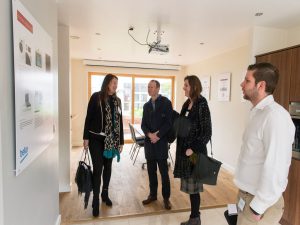
Collaboration was the order of the day at the Constructing Excellence Sustainability Theme Group Meeting on Specifying Innovative and Sustainable Systems. The workshop, delivered in partnership with the Innovation Gateway and hosted at the BRE Innovation Park, looked at how innovative solutions move from concept to widespread implementation and use within the built environment. With over 40 participants, it featured presentations from innovators and a panel discussion on how the Innovation Gateway is working with major property owners and facilities managers to provide access for small innovative companies.
The day was chaired by Dr Paul Toyne and included inputs from:
- Ed Suttie, Director, BRE (The Biophilic Office Project)
- Dale Edgington, EndoTherm
- Samantha Warren-Mant, Halcyan Water Conditioners
- Jack Sweeney, AirClean by Tobermore
- Henry Majed, Director, Innovation Gateway
- James Tiernan, Group Energy & Environmental Manager, Unite Students
- Euan Burns, Chief Engineer, Carillion
- Nigel Bamford, Managing Director, Waterblade
- Graham Simmonds, Director, Jump

A number of themes and key questions came through from the workshop which are highlighted in bold in the write up below.
Could the focus on wellbeing accelerate innovation?
Ed Suttie proposed that the current focus on Health & Wellbeing could be the stimulus we need for the next wave of sustainable buildings. With a clear focus on building occupants and their behaviour this will ultimately have a more tangible impact on organisational P&L and ultimately make the business case for investment much stronger. To really make this concept fly the delegates identified the need to involve HR departments to ensure that clear linkage is made with the business case.
Evidence, evidence, evidence…
Evidence was seen as critical to getting innovations specified and procured. Each innovator and client reinforced the need to provide evidence and data on how the product actually performed. Waterblade re-interated the requirement for good credible data backed up by relevant use cases and praised the role that the Innovation Gateway had played in providing access to pilot projects and real use cases.
Third party verification and endorsement is an important step in providing confidence in the claims made about the product. EndoTherm have used competitions such as the Ecobuild Big Innovation Pitch and CIBSE awards to demonstrate their credentials as well as achieving verification from the Energy Savings Trust. They are in the final stages of carrying out Environmental Technology Verification with BRE, an EU supported scheme that allows technologies that due to their innovative nature do not fit with existing standards to have their performance verified by approved test centres.
Tobermore got around the issue of evidence by partnering with German Company Nudling, who had already proven the concept of photocatalytic paving in Germany, which absorbs nitrogen oxides, and carried out all of the required testing and evidence. This significantly speeded up the route to market for the technology in the UK.

Fail fast and iterate again
Both Carillion and Unite discussed the need to speed up the rate at which they adopt new technologies. With the current pace of change in the wider technological landscape there is a real need to embrace technologies. Failing slowly is the death of innovation, considerable time and cost can be wasted unnecessarily, therefore there is a need to fail fast, learn from what went wrong and re-iterate. Both clients were impressed with how the Innovation Gateway is helping them to speed up and de-risk their innovation activities.
The power of many
This event was all about partnering and collaboration. A key theme of the Innovation Gateway is ‘the power of many’, this sits very closely with our own vision at Constructing Excellence of ‘excellence through collaboration’. Throughout the event the idea of collaborating with others to speed up innovation, make it more suitable for target markets or indeed to source and test ideas was a critical factor for success.
The Innovation Gateway allows innovators and clients to jointly develop business cases and value propositions, ensuring that innovator understand how their value propositions relate across the supply chain. BRE is bringing together a consortium of partners to work on the Biophillic Office Project and consider how innovation can be used to deliver better health and wellbeing outcomes, indeed the BRE Innovation Park itself stands as testimony of how industry-wide collaboration can stimulate significant innovation.
The next meeting of the Sustainability Group will be in September with further details to follow. Please contact [email protected] to get involved.
